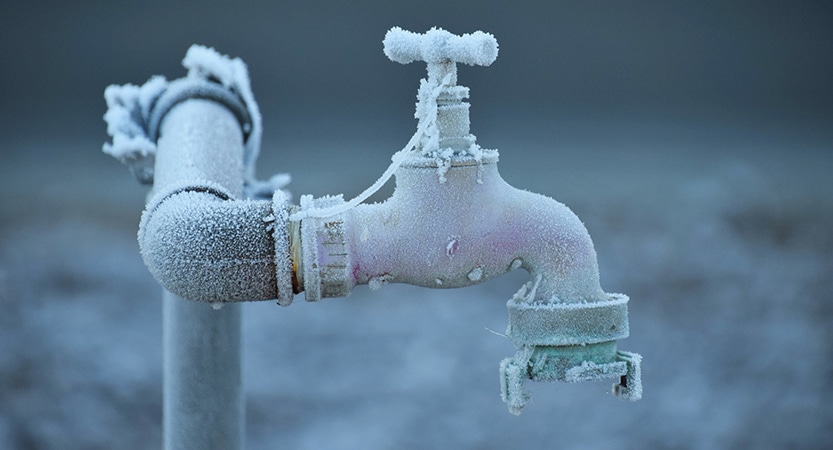Avoid Frozen Plumbing in Winter: Expert Advice
Avoid Frozen Plumbing in Winter: Expert Advice
Blog Article
We've stumbled upon this post relating to How to prepare your home plumbing for winter weather listed below on the internet and felt it made good sense to talk about it with you on my blog.

Cold weather can damage your plumbing, especially by freezing pipelines. Here's exactly how to prevent it from happening and what to do if it does.
Introduction
As temperatures decrease, the danger of icy pipes boosts, potentially causing expensive repair services and water damages. Recognizing just how to stop icy pipes is vital for home owners in cool climates.
Understanding Frozen Pipes
What creates pipelines to ice up?
Pipes freeze when exposed to temperatures listed below 32 ° F (0 ° C) for expanded durations. As water inside the pipes freezes, it broadens, putting pressure on the pipeline wall surfaces and possibly triggering them to burst.
Threats and damages
Icy pipelines can cause water supply interruptions, residential or commercial property damages, and pricey repairs. Burst pipes can flooding homes and trigger considerable architectural damages.
Signs of Frozen Pipes
Identifying frozen pipes early can prevent them from rupturing.
Just how to recognize frozen pipelines
Seek lowered water circulation from faucets, unusual smells or sounds from pipes, and noticeable frost on exposed pipes.
Avoidance Tips
Protecting susceptible pipes
Cover pipelines in insulation sleeves or use warm tape to protect them from freezing temperature levels. Concentrate on pipes in unheated or exterior locations of the home.
Home heating methods
Keep indoor rooms properly heated up, particularly areas with plumbing. Open up cupboard doors to permit warm air to circulate around pipes under sinks.
Securing Outside Pipes
Yard pipes and exterior taps
Separate and drain pipes yard hose pipes before winter. Mount frost-proof faucets or cover outside faucets with shielded caps.
What to Do If Your Pipelines Freeze
Immediate actions to take
If you believe icy pipes, maintain faucets open to soothe pressure as the ice thaws. Utilize a hairdryer or towels soaked in warm water to thaw pipes gradually.
Long-Term Solutions
Structural modifications
Consider rerouting pipelines away from exterior wall surfaces or unheated areas. Include added insulation to attics, cellars, and crawl spaces.
Updating insulation
Purchase top quality insulation for pipes, attic rooms, and walls. Appropriate insulation helps maintain regular temperature levels and reduces the threat of frozen pipes.
Conclusion
Preventing frozen pipes requires aggressive steps and fast responses. By recognizing the causes, indicators, and safety nets, house owners can safeguard their pipes during cold weather.
5 Ways to Prevent Frozen Pipes
Drain Outdoor Faucets and Disconnect Hoses
First, close the shut-off valve that controls the flow of water in the pipe to your outdoor faucet. Then, head outside to disconnect and drain your hose and open the outdoor faucet to allow the water to completely drain out of the line. Turn off the faucet when done. Finally, head back to the shut-off valve and drain the remaining water inside the pipe into a bucket or container. Additionally, if you have a home irrigation system, you should consider hiring an expert to clear the system of water each year.
Insulate Pipes
One of the best and most cost-effective methods for preventing frozen water pipes is to wrap your pipes with insulation. This is especially important for areas in your home that aren’t exposed to heat, such as an attic. We suggest using foam sleeves, which can typically be found at your local hardware store.
Keep Heat Running at 65
Your pipes are located inside your walls, and the temperature there is much colder than the rest of the house. To prevent your pipes from freezing, The Insurance Information Institute suggests that you keep your home heated to at least 65 degrees, even when traveling. You may want to invest in smart devices that can keep an eye on the temperature in your home while you’re away.
Leave Water Dripping
Moving water — even a small trickle — can prevent ice from forming inside your pipes. When freezing temps are imminent, start a drip of water from all faucets that serve exposed pipes. Leaving a few faucets running will also help relieve pressure inside the pipes and help prevent a rupture if the water inside freezes.
Open Cupboard Doors
Warm your kitchen and bathroom pipes by opening cupboards and vanities. You should also leave your interior doors ajar to help warm air circulate evenly throughout your home.

As an avid person who reads about Helpful Tips to Prevent Frozen Pipes this Winter, I thought sharing that excerpt was sensible. Are you aware of another individual who is fascinated by the subject? Be sure promote it. Kudos for your time. Kindly pay a visit to our blog back soon.
Estimating Report this page